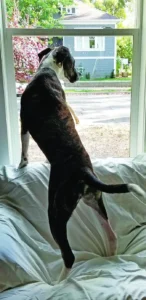A Guide to Addressing and Redirecting Problematic Canine Conduct
When our furry friends misbehave, our instinctive response is often a firm “NO!” We’ve all been there. However, dog trainers frequently advise against using this word. Why? Shouldn’t we correct our dogs when they make mistakes?
The truth is, simply saying “no” (even loudly) rarely solves the problem. (If it did, my phone would stop ringing, and I’d be out of a job!) Moreover, using intimidation to stop unwanted behaviors can harm your relationship with your dog. Lastly, “no” provides no guidance; it fails to tell your dog what they should do instead.
So, if “no” isn’t the answer, how can we effectively stop unwanted behavior? Here’s a five-step formula you can apply to almost any problematic behavior for excellent results:

1. Implement management techniques
“Management” is dog trainer speak for prevention. It means ensuring your dog doesn’t have the opportunity to “practice” the behavior you want to stop. Whether it’s chewing shoes, jumping on kids, or barking at passing dogs, the goal is to prevent the behavior until you can teach an alternative.
Get creative with your management strategies. Use baby gates, crates, window coverings, and leashes. For a mouthy puppy, keep a toy handy when petting. If your dog barks at things outside, block their view of the window. For dogs that jump on visitors, use a baby gate to prevent them from rushing the door. Once management is in place, move on to step two.
2. Eliminate reinforcement
Dogs always have a reason for their behaviors, even if we don’t like them. It could be a normal dog behavior needing an alternative outlet, anxiety relief, or simply fun (like jumping on us). Sometimes, these behaviors express frustration or fear (such as barking or destroying carpets).
Try to understand the motivation behind the behavior. Does jumping get your attention? Does raiding the trash alleviate boredom? Does running with a stolen sponge initiate a game of chase? Does pulling on the leash allow the dog to investigate interesting smells? Before you can effectively stop an unwanted behavior, identify what reinforces it and either remove that reinforcement or meet the dog’s need differently.
3. Teach an alternative behavior
Saying “no” doesn’t tell your dog what to do instead. Teaching an alternative behavior is crucial for solving problem behaviors. This requires a shift in our thinking:
- Instead of jumping, teach your dog to greet people calmly with all paws on the ground.
- Replace begging at mealtimes with settling on a bed.
- Instead of barking at the window, teach your dog to alert you calmly about outdoor concerns.
- Replace leash lunging with sitting while you unclip the leash before play.
- Instead of leash pulling, teach loose-leash walking.
- Replace running off with staying within a certain radius during off-leash walks.
By identifying a desirable alternative behavior, you create an achievable goal. From there, you can develop a training plan to reach that goal.
4. Use a positive interrupter
It’s okay to stop your dog from doing something unsafe or annoying. The key is how you do it. Clear and consistent feedback can be effective.
A positive interrupter is a sound or word that redirects your dog’s attention to you. It should be associated with good things (usually treats) so that your dog responds happily. To train a positive interrupter:
- Choose a sound (like a kissy noise) or word (like “yip!”).
- When your dog is calm, make the sound and immediately give a treat.
- Repeat this process in various locations until your dog consistently looks at you when hearing the sound.
- Once reliable, use the interrupter when you catch your dog about to misbehave.
- When your dog looks at you, redirect to an appropriate behavior and reward

5. Reinforce desired behaviors
The final step is to consistently reinforce the behaviors you want to see. This means rewarding your dog generously when they make good choices. Did your dog greet a visitor without jumping? Offer praise and treats. Did they settle on their bed during dinner? Toss them a piece of kibble. Did they walk nicely on the leash? Stop for a quick play session.
Remember, behaviors that are reinforced are more likely to be repeated. By focusing on and rewarding the behaviors you want, you’ll see them increase while unwanted behaviors naturally decrease.
Implementing these five steps – management, removing reinforcement, teaching alternatives, using positive interruption, and reinforcing desired behaviors – can help address most unwanted dog behaviors effectively and positively. This approach not only solves immediate issues but also strengthens your bond with your furry friend, creating a happier, more harmonious relationship.
For instance, if you notice your dog contemplating a leap onto the sofa and you’d prefer they didn’t, you can calmly and consistently interrupt the action and guide them to their own bed.
I prefer using what’s called a positive interrupter (PI). PIs come in various forms. The one I find most effective is a sound or word that conveys, “Stop what you’re doing and focus on me!” It’s surprisingly easy to teach initially, but it requires considerable practice to apply it effectively in more challenging situations.
To introduce a positive interrupter:
a) Select a word or sound.
Many opt for a kissing sound or tongue click. Some use “Watch!” or “Look!” Alternatively, you can take a more traditional approach with “Leave it!” or “No!” The specific word isn’t crucial; what matters is how you say it and the meaning you attach to it. The word serves as a cue; it’s not meant to threaten or intimidate the dog. Use it in a clear, upbeat tone, as you would with any command.
This is particularly important if you choose a word like “No!” as your PI. Most people often use “No!” as a stern order or a threat of punishment, and find it challenging to consistently say it cheerfully. Try to think of it as just another random cue and maintain a positive tone!
b) Use your PI and immediately reward your dog with a fantastic treat.
This is the time to use high-value treats: chicken, roast beef, or whatever your dog loves most. Say your PI cheerfully and promptly give your dog several pieces of the treat, one after another. Repeat this about a dozen times, or until your dog looks at you expectantly upon hearing the PI. You’re using classical conditioning to create a conditioned emotional response (CER) to the word. This step will help your dog respond even around highly tempting distractions later on.
c) Train your dog to disengage and look at you.
Cheerfully say your PI when your dog is slightly distracted. If they’ve developed a CER to the word, they’ll look back at you expecting the treat. At this point, “mark” the moment they look back with a signal, such as a clicker click or the word “Yes!” and then give them several pieces of the treat in succession. Repeat until your dog happily and eagerly orients to you each time they hear the PI.
d) Practice with distractions.
Begin with easy distractions like a piece of paper or a boring toy. Gradually increase the difficulty of distractions. For challenging distractions like a squirrel in the trees, you may need to practice from a distance initially. Continue reinforcing your dog when they orient back to you until they can do it in most circumstances. At that point, you can start using your PI to interrupt your dog when they’re doing something you’d rather they didn’t.
Interrupters work in the moment but don’t necessarily teach your dog not to repeat the behavior in the future. An interrupter is a temporary solution. If you consistently follow your interrupter with a cue for an alternative behavior, you’re more likely to achieve long-term success. For example, if your puppy starts chewing on a table leg, you can use your PI and then redirect them to chew on a toy instead.
5. Use force-free corrections sparingly.
Yes, there are ways to “correct” a dog without resorting to pain or intimidation.
Timeouts are one example. A timeout removes the opportunity for reinforcement. If your puppy bites your hand during play, you can “mark” the moment their teeth touch your skin with an “ouch” or other noise and pause play for five to ten seconds – then resume. When repeated several times in a play session, the puppy should realize that teeth on skin stops the fun – not good! They’ll try to avoid mouthing you in the future to keep the play going.
Other similar corrective measures include walking away from your dog, putting toys or treats out of reach, or preventing your dog from engaging in an activity they enjoy. This approach can be effective at stopping behaviors reinforced by your attention.
However, timeouts require excellent timing and must be used consistently. If your dog isn’t clear about what’s stopping the play, for example, they may become frustrated, and frustration can lead to an increase in unwanted behavior. Use timeout techniques sparingly, if at all.
Tailor the Approach
In most cases, the first three steps (implementing management, removing reinforcement, and teaching an alternative behavior) will effectively stop unwanted behaviors. Interrupters may help with behaviors that are harder to manage, and timeouts can be used sparingly for behaviors reinforced by your attention.
Remember, progress in curbing unwanted behaviors isn’t always straightforward. You might need to reassess and adjust your training strategies repeatedly until you discover the approach that works best for both you and your furry companion.

